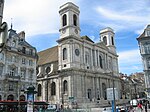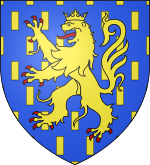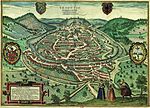Francia

The Kingdom of the Franks (Latin: Regnum Francorum), also known as the Frankish Kingdom, the Frankish Empire (Latin: Imperium Francorum) or Francia, was the largest post-Roman barbarian kingdom in Western Europe. It was ruled by the Frankish Merovingian and Carolingian dynasties during the Early Middle Ages. Francia was among the last surviving Germanic kingdoms from the Migration Period era. The original core Frankish territories inside the former Western Roman Empire were close to the Rhine and Meuse rivers in the north, but Franks such as Chlodio and Childeric I expanded Frankish rule into what is now northern France. A single kingdom uniting all Franks was founded by Clovis I, the son of Childeric, who was crowned King of the Franks in 496. He founded the Merovingian dynasty, which was eventually replaced by the Carolingian dynasty. Under the nearly continuous campaigns of Pepin of Herstal, Charles Martel, Pepin the Short, Charlemagne, and Louis the Pious—father, son, grandson, great-grandson and great-great-grandson—the greatest expansion of the Frankish empire was secured by the early 9th century, and is by this point referred to as the Carolingian Empire. During the Merovingian and Carolingian dynasties the Frankish realm was one large polity, generally subdivided into several smaller kingdoms ruled by different members of the ruling dynasties. These coordinated but also regularly came into conflict with each other. The old Frankish lands, for example, were initially contained within the kingdom of Austrasia, centred on the Rhine and Meuse, roughly corresponding to later Lower Lotharingia. The Gallo-Roman territory to its south and west was called Neustria. The exact borders and number of these subkingdoms varied over time, until a basic split between eastern and western domains became persistent. After various treaties and conflicts in the late-9th and early-10th centuries, West Francia continued as the medieval Kingdom of France, while East Francia and Lotharingia came under the control of the non-Frankish Ottonian dynasty, and became the core of the medieval Holy Roman Empire.
Excerpt from the Wikipedia article Francia (License: CC BY-SA 3.0, Authors, Images).Francia
Place Jouffroy d'Abbans, Besançon Rue Battant
Geographical coordinates (GPS) Address Nearby Places Show on map
Geographical coordinates (GPS)
| Latitude | Longitude |
|---|---|
| N 47.24 ° | E 6.02 ° |
Address
Place Jouffroy d'Abbans
25000 Besançon, Rue Battant
Bourgogne-Franche-Comté, France
Open on Google Maps









